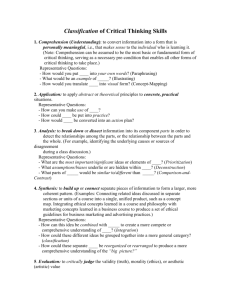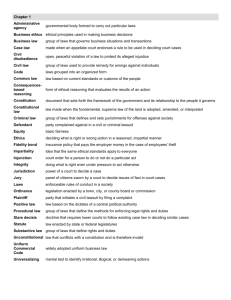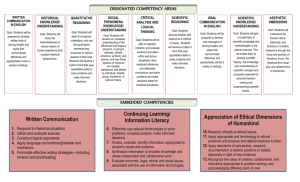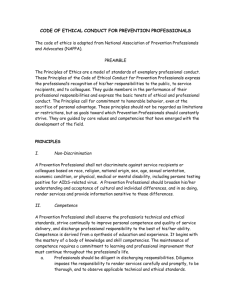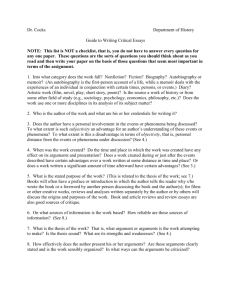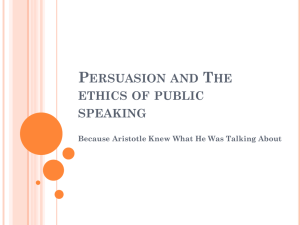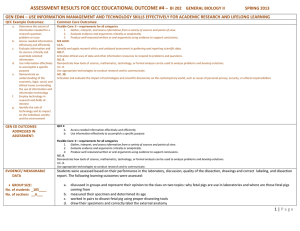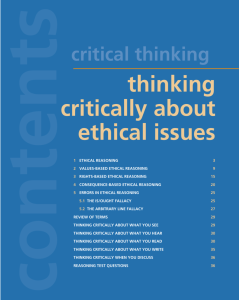Course Number: Course Name: Instructor: TAP Outcomes and
advertisement
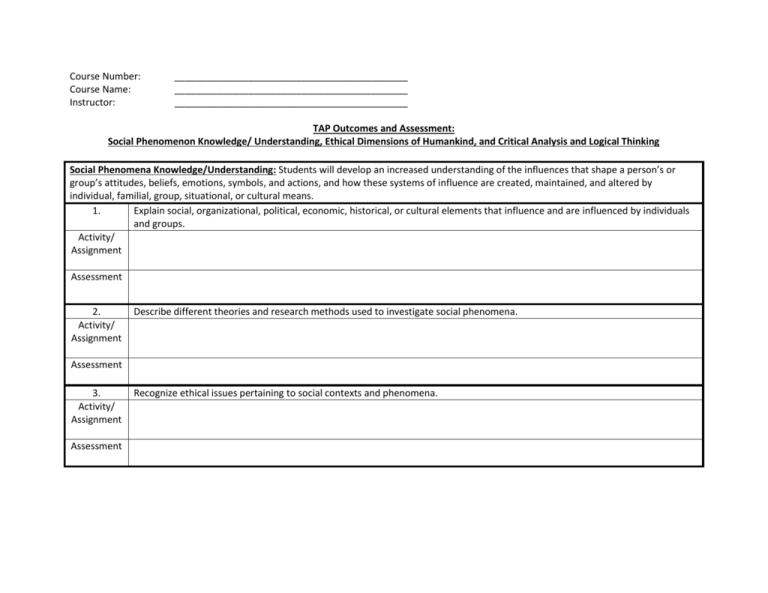
Course Number: Course Name: Instructor: ____________________________________________ ____________________________________________ ____________________________________________ TAP Outcomes and Assessment: Social Phenomenon Knowledge/ Understanding, Ethical Dimensions of Humankind, and Critical Analysis and Logical Thinking Social Phenomena Knowledge/Understanding: Students will develop an increased understanding of the influences that shape a person’s or group’s attitudes, beliefs, emotions, symbols, and actions, and how these systems of influence are created, maintained, and altered by individual, familial, group, situational, or cultural means. 1. Explain social, organizational, political, economic, historical, or cultural elements that influence and are influenced by individuals and groups. Activity/ Assignment Assessment 2. Activity/ Assignment Describe different theories and research methods used to investigate social phenomena. Assessment 3. Activity/ Assignment Assessment Recognize ethical issues pertaining to social contexts and phenomena. 4. Activity/ Assignment Explain issues of diversity within and across cultures. Assessment 5. Activity/ Assignment Assessment Apply concepts or theories of social phenomena to real world situations. (e.g., service learning, group work, clubs, organizations, civic engagement, conflict resolution, and internships). Ethical Dimensions of Humankind: Students will identify ethical principles that guide individual and collective actions and apply those principles to the analysis of contemporary social and political problems. 1. Respond critically to ethical issues. Activity/ Assignment Assessment 2. Activity/ Assignment Apply appropriate concepts and terminology in identifying ethical problems, proposing and defending solutions to them. Assessment 3. Apply standards and practices of scholarship, research, and documentation to defend positions and beliefs, including reevaluating beliefs in light of unforeseen implications or new evidence. Activity/ Assignment Assessment 4. Activity/ Assignment Assessment Recognize the value of creative, collaborative, and innovative approaches to problem-solving, including the ability to acknowledge differing points of view. Critical Analysis and Logical Thinking: Students will be able to organize, interpret, and evaluate evidence and ideas within and across disciplines; draw reasoned inferences and defensible conclusions; and solve problems and make decisions based on analytical processes. 1. Demonstrate competence in argumentation by identifying issues, evidence and reasoning processes: recognizing various types of arguments, analyzing components of arguments, and formulating good arguments, including a significant focus on inductive reasoning as outlined below: Identify the presence of arguments, as distinguishable from explanations, illustrations, descriptions, or creative works. Identify the components of an argument (premise/ evidence and conclusion/ thesis) and demonstrate an understanding between these components. Identify the different types of reasoning (e.g. generalization, analogy, induction, deduction, and “reasoning to the best explanation”). Activity/ Assignment Assessment 2. Activity/ Assignment Assessment Demonstrate competence in analysis by breaking subject matter into components and identifying their interrelations to ascertain the defining features of the work and their contributions to the whole as outlined below: Distinguish fact from opinion. Examine works in order to identify distinct elements, patterns, and their interrelationships and express their significance. 3. Demonstrate competence in identifying assumptions, assessing the quality and reliability of sources of evidence, and learning the criteria for evaluating the success of each kind of interference as outlined below: Assess the reliability, reasonableness, and perspective of the sources of evidence. Identify their own assumptions and minimize confirmation (“my-side”) bias while considering viewpoints other than their own. Apply criteria for evaluating the success of each kind of interference. Activity/ Assignment Assessment 4. Activity/ Assignment Assessment Draw together disparate claims into a coherent whole in order to arrive at well-reasoned and well- supported interferences that can be justified as a conclusion as outlined below: Develop and present an integrated, well-reasoned, and well-supported independent interpretation of ideas based on appropriate evidence and methodology.
